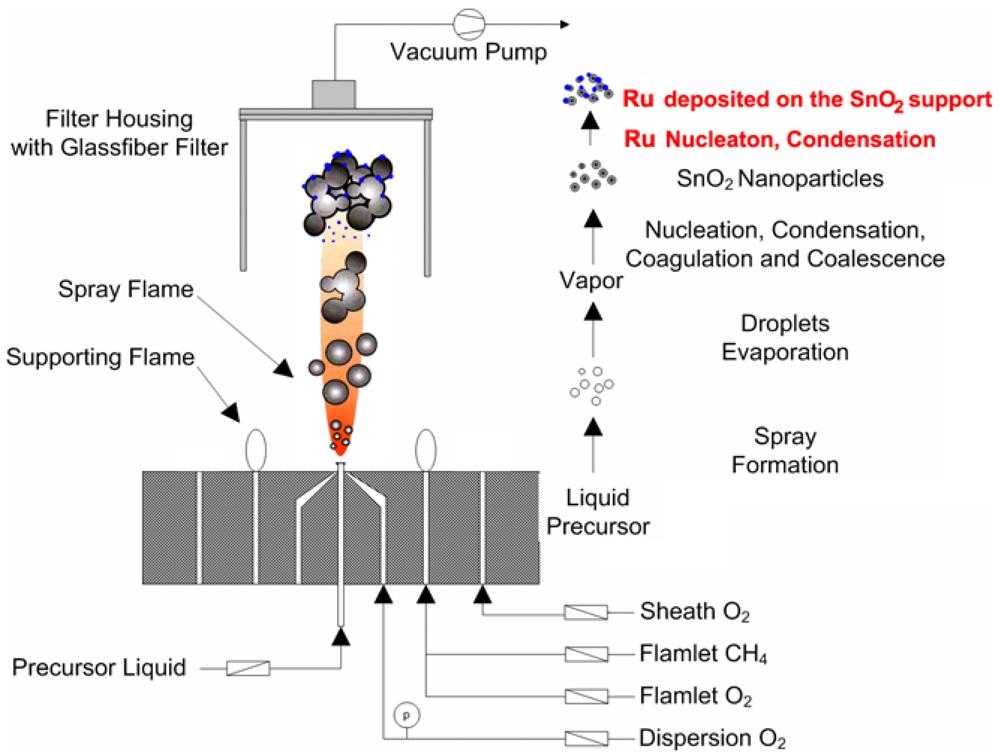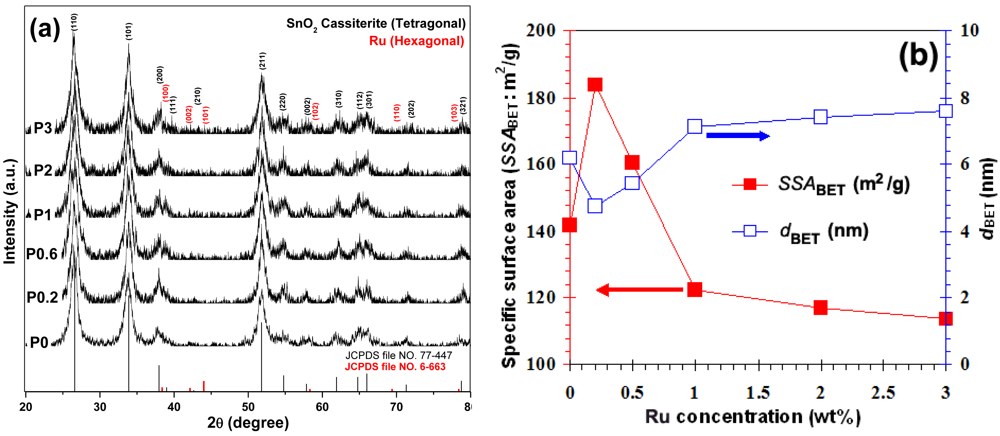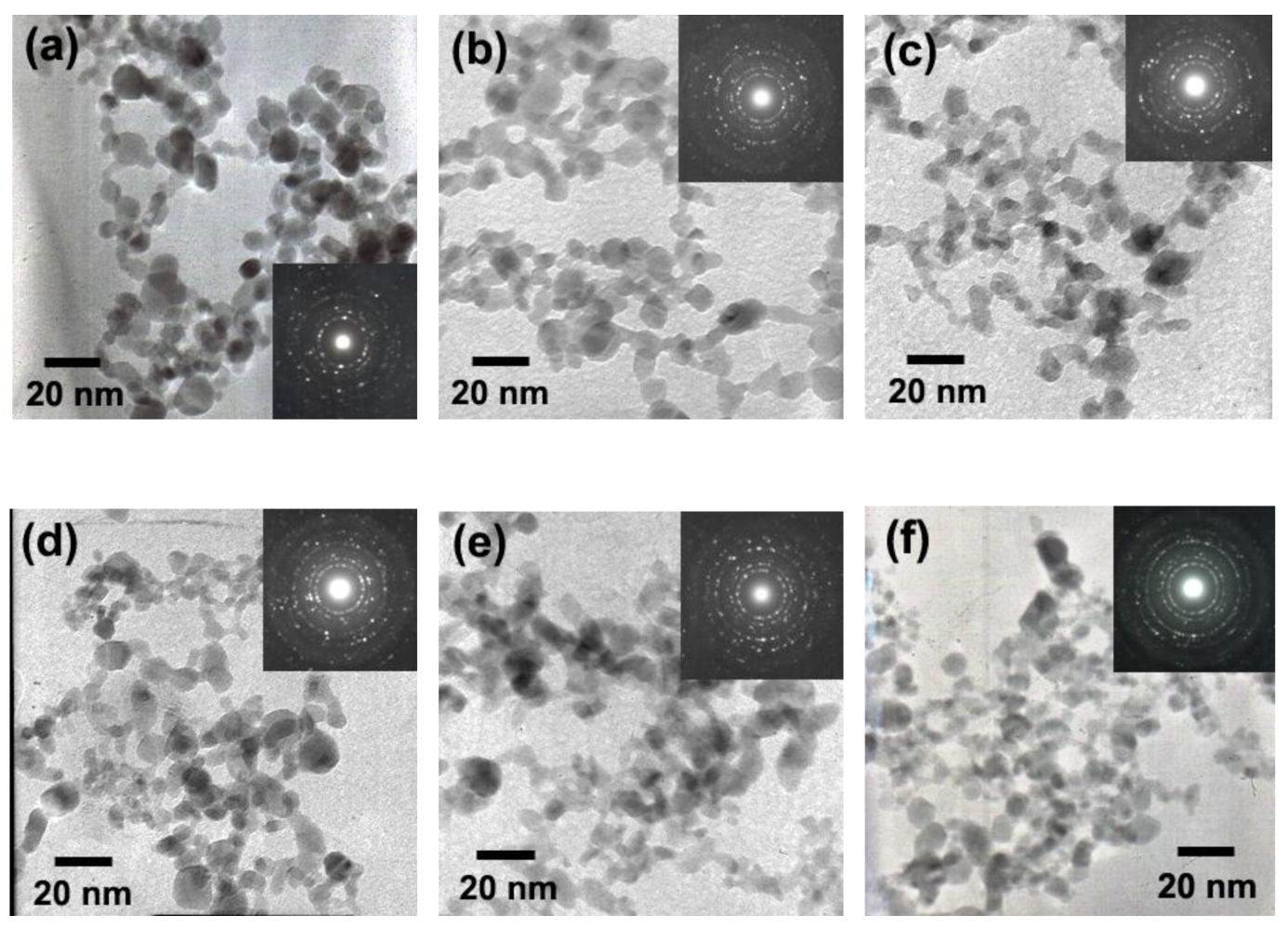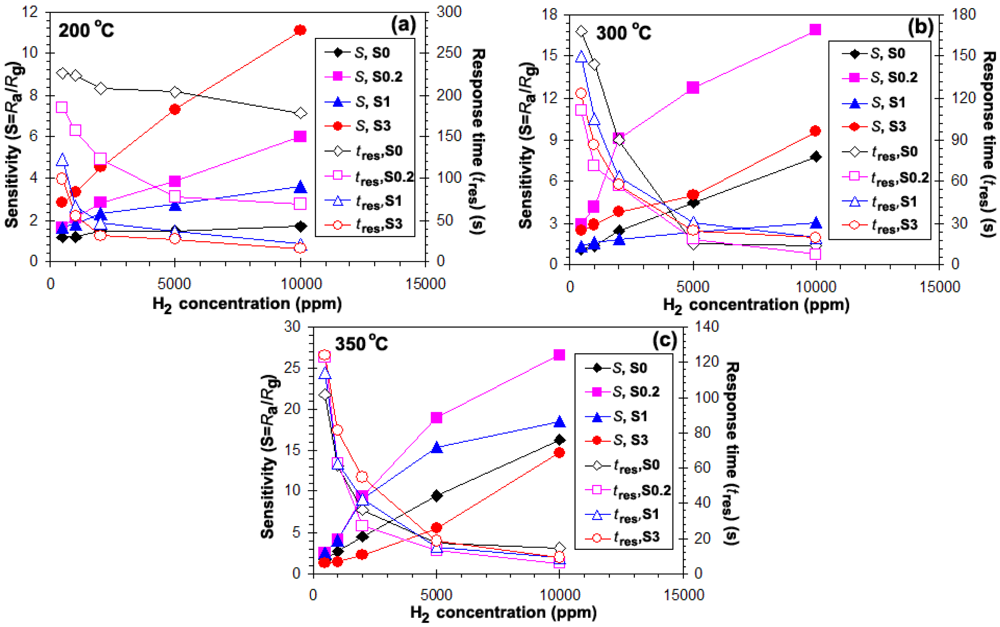H2 Sensing Response of Flame-spray-made Ru/SnO2 Thick Films Fabricated from Spin-Coated Nanoparticles
Abstract
:1. Introduction
2. Experimental
2.1. Flame Synthesis of Nanopowders
2.2. Powder Characterizations
2.3. Paste and Sensor Preparations
2.4. Sensor Measurement
3. Results and Discussion
3.1. Nanopowder Properties
3.2. Gas Sensing Properties
3.3. SEM-Film Thickness Sensing Layer
4. Conclusions
Acknowledgments
References and Notes
- Sahm, T; Mädler, L.; Gurlo, A.; Barsan, N.; Pratsinis, S.E.; Weimar, U. Flame spray synthesis of tin dioxide nanoparticles for gas sensing. Sens. Actuat. B-Chem. 2004, 98, 148–153. [Google Scholar]
- Mädler, L.; Roessler, A.; Pratsinis, S.E.; Sahm, T.; Gurlo, A.; Barsan, N.; Weimar, U. Direct formation of highly porous gas-sensing films by in situ thermophoretic deposition of flame-made Pt/SnO2 nanoparticles. Sens. Actuat. B-Chem. 2005, 114, 283–295. [Google Scholar]
- Mädler, L.; Sahm, T.; Gurlo, A.; Grunwaldt, J.-D.; Barsan, N.; Weimar, U.; Pratsinis, S.E. Sensing low concentrations of CO using flame-spray-made Pt/SnO2 nanoparticles. J. Nanopart. Res. 2006, 8, 783–796. [Google Scholar]
- Ponce, M.A.; Castro, M.S.; Aldao, C.M. Resistance and capacitance analysis of Pd-doped and undoped SnO2 thick films sensors exposed to CO atmospheres. Ceram. Inter. 2006, 32, 733–737. [Google Scholar]
- Safonova, O.V.; Rumyantseva, M.N.; Ryabova, L.I.; Labeau, M.; Delabouglise, G.; Gaskov, A.M. Effect of combined Pd and Cu doping on microstructure, electrical and gas sensor properties of nanocrystalline tin dioxide. Mater. Sci. Eng. 2001, B85, 43–49. [Google Scholar]
- Baik, N.S.; Sakai, G.; Miura, N.; Yamazoe, N. Hydrothermally treated sol solution of tin oxide for thin-film gas sensor. Sens. Actuat. B-Chem. 2000, 63, 74–79. [Google Scholar]
- Katsuki, A.; Fukui, K. H2 selective gas sensor based on SnO2. Sens. Actuat. B-Chem. 1998, 52, 30–37. [Google Scholar]
- Chi-Hwan, H.; Sang-Do, H.; Singh, I.; Toupance, T. Micro-bead of nano-crystalline F-doped SnO2 as a sensitive hydrogen gas sensor H2 selective gas sensor based on SnO2. Sens. Actuat. B-Chem. 2005, 109, 264–269. [Google Scholar]
- Salehi, A. Selectivity enhancement of indium-doped SnO2 gas sensors. Thin Solid Films. 2002, 416, 260–263. [Google Scholar]
- Ryzhikov, A.S.; Shatokhin, A.N.; Putilin, F.N.; Rumyantseva, M.N.; Gaskov, A.M.; Labeau, M. Hydrogen sensitivity of SnO2 thin films doped with Pt by laser ablation. Surf. Coat. Technol. 2005, 107, 387–391. [Google Scholar]
- Niranjan, R.S.; Hwang, Y.K.; Kim, D.-K.; Jhung, S.H.; Chang, J.-S.; Mulla, I.S. Nanostructured tin oxide: Synthesis and gas-sensing properties. Mater. Chem. Phys. 2005, 92, 384–388. [Google Scholar]
- Hyodo, T.; Sasahara, K.; Shimizu, Y.; Egashira, M. Preparation of macroporous SnO2 films using PMMA microspheres and their sensing properties to NOx and H2. Sens. Actuat. B-Chem. 2005, 106, 580–590. [Google Scholar]
- Bukun, N; Vinokurov, A.; Vinokurova, M.; Derlyukova, L.; Dobrovolsky, Y.; Levchenko, A. Chemisorption and electrochemical reactions of SO2 on modified SnO2 electrodes. Sens. Actuat. B-Chem. 2005, 106, 153–157. [Google Scholar]
- Lančok, J.; Santoni, A.; Penza, M.; Loreti, S.; Menicucci, I.; Minarini, C.; Jelinek, M. Tin oxide thin films prepared by laser-assisted metal-organic CVD: Structural and gas sensing properties. Surf. Coat. Technol. 2005, 200, 1057–1060. [Google Scholar]
- Wang, Y.D.; Wu, X.H.; Su, Q.; Li, Y.F.; Zhou, Z.L. Ammonia-sensing characteristics of Pt and SiO2 doped SnO2 materials. Solid-state Elec. 2001, 45, 347–350. [Google Scholar]
- Teeramonglonrasmee, A.; Sriyudthsak, M. Methanol and ammonia sensing characteristics of sol-gel derived thin film gas sensor. Sens. Actuat. B-Chem. 2000, 66, 256–259. [Google Scholar]
- Jin, C.; Yamazaki, T.; Ito, K.; Kikuta, T.; Nakatani, N. H2S sensing properties of porous SnO2 sputerred films coated with various doping films. Vacuum. 2006, 80, 723–725. [Google Scholar]
- Rella, R.; Serra, A.; Siciliano, P.; Vasanelli, L.; De, G.; Licciulli, A.; Quirini, A. Tin oxide-based gas sensors prepared by the sol-gel process. Sens. Actuat. B-Chem. 1997, 44, 462–467. [Google Scholar]
- Tiburcio-Silver, A.; Sánchez-Juárez, A. SnO2:Ga thin films as oxygen gas sensor. Mater. Sci. Eng. 2004, 110, 268–271. [Google Scholar]
- Maffeïs, T.G.G.; Owen, G.T.; Penny, M.W.; Starke, T.K.H.; Clark, S.A.; Ferkel, H.; Wilks, S.P. Nano-crystalline SnO2 gas sensor response to O2 and CH4 at elevated temperature investigated by XPS. Surf. Sci. 2002, 520, 29–34. [Google Scholar]
- Pratsinis, S.E. Flame aerosol synthesis of ceramic powders. Prog. Energ. Combust. 1998, 24, 197–219. [Google Scholar]
- Mädler, L.; Kammler, H.K.; Mueller, R.; Pratsinis, S.E. Controlled synthesis of nanostructured particles by flame spray pyrolysis. J. Aeros. Sci. 2002, 33, 369–389. [Google Scholar]
- Mueller, R.; Mädler, L.; Pratsinis, S.E. Nanoparticle synthesis at high production rates by flame spray pyrolysis. Chem. Eng. Sci. 2003, 58, 1969–1976. [Google Scholar]
- Mädler, L.; Stark, W.J.; Pratsinis, S.E. Rapid synthesis of stable ZnO quantum dots. J. Appl. Phys. 2002, 92, 6537–6540. [Google Scholar]
- Kammler, H.K.; Mädler, L.; Pratsinis, S.E. Flame synthesis of nanoparticles. Chem. Eng. Tech. 2001, 24, 583–596. [Google Scholar]
- Lide, D. R. Properties of the elements and inorganic compounds. In CRC Handbook of Chemistry and Physics., 87th ed.; Taylor & Francis: New York, NY, USA, 2006; pp. 4–141. [Google Scholar]
- Liewhiran, C.; Phanichphant, S. Influence of thickness on ethanol sensing characteristics of doctor-bladed thick film from flame-made ZnO nanoparticles. Sensors. 2007, 7, 185–201. [Google Scholar]
- Liewhiran, C.; Phanichphant, S. Improvement of flame-made nanoparticulate thick film morphology for ethanol sensing. Sensors. 2007, 7, 650–675. [Google Scholar]
- Liewhiran, C.; Phanichphant, S. Effects of palladium loading on the response of a thick film flame-made zno gas sensor for detection of ethanol vapor. Sensors. 2007, 7, 1159–1184. [Google Scholar]
- Liewhiran, C.; Phanichphant, S. Doctor-bladed thick films of flame-made Pd/ZnO nanoparticles for ethanol sensing. Curr. Appl. Phys. 2008, 8, 336–339. [Google Scholar]
- Takeuchi, T.; Sato, H.; Mizutani, U. Investigation of Hume-Rothery stabilization mechanism from an initio band calculation for different electron compounds: Cu5Zn8 and Al-Mg-Zn, Al-Cu-Ru-Si approximants. J. Alloy. Compd. 2002, 342, 355–359. [Google Scholar]
- Kreiner, G.; Moguilnikov, Y.; Burkhardt, U.; Schäpers, M. Hume-Rothery controlled formation of structurally complex alloy phases in the ternary Ga-Mg-Pd system. J. Non-Cryst. Solids. 2004, 334-335, 17–22. [Google Scholar]
- Tsai, A.-P. A test of Hume-Rothery rules for stable quasicrystals. J. Non-Cryst. Solids. 2004, 334-335, 317–222. [Google Scholar]
- Clementi, E.; Raimondi, D.L.; Reinhardt, W.P. Atomic Screening Constants from SCF Functions. II. Atoms with 37 to 86 Electrons. J. Chem. Phys. 1967, 47, 1300–1307. [Google Scholar]
- Lide, D.R. Properties of solid. In CRC Handbook of Chemistry and Physics., 87th ed.; Taylor & Francis: New York, NY, USA, 2006; pp. 12–209. [Google Scholar]
- Capobianco, C.J. Ruthenium solubility in hematite. Amer. Mineral. 1998, 83, 1152–1160. [Google Scholar]
- Wiley, J.B.; Poeppelmeier, K.R. Reduction chemistry of platinum group metal perovskites. Mater. Res. Bull. 1991, 26, 1201–1210. [Google Scholar]
- Kaim, W.; Sarkar, B. Mixed valency in ruthenium complexes-coordinative aspects. Coordin. Chem. Rev. 2007, 251, 584–594. [Google Scholar]








| Authors | Method | Doping level | Gas Concentration | Sensing performances |
|---|---|---|---|---|
| Sahm et al. [1] | FSP (nanopowders) Drop coating (sensors) | Pure SnO2 | NO2 (10–5,000 ppb), CO (500–10,000 ppm), propanol (10–300 ppm) | NO2; Sensitivity: ∼20 to 5,000 ppb at 220 °C |
| Propanal; Sensitivity: ∼300 to 150 ppm at 220 °C | ||||
| Mädler et al. [2] | FSP (nanopowders) Thermophoretic deposition (sensors) | 0.2 wt%Pt/SnO2 | CO; 50 ppm | Sensitivity: 8 to 50 ppm at 350 °C |
| Salehi [9] | Evaporation, Chemical Vapor Deposition, Spray Pyrolysis, Sputtering | In/SnO2 | H2; 500–3,000 ppm | Response to 7% H2 at 200 °C of 0.5 s |
| Ryzhikov et al. [10] | Magnetron Sputtering: Sensing film; Laser Ablation: Doping process | Pt/SnO2 | H2; 20–20,000 ppm | Sensitivity: 630 to 1,000 ppm at 300 °C |
| Niranjan et al. [11] | Modified Pechini Route | 0.2–0.7 wt%Ru/SnO2 | H2; 700 vol ppm | 0.6 wt%Ru/SnO2 Sensitivity: 150 at 275 °C |
| Response time: 3 s at 275 °C | ||||
| Recovery time: 5–10 min at 275 °C |
© 2009 by the authors; licensee Molecular Diversity Preservation International, Basel, Switzerland. This article is an open access article distributed under the terms and conditions of the Creative Commons Attribution license (http://creativecommons.org/licenses/by/3.0/).
Share and Cite
Liewhiran, C.; Tamaekong, N.; Wisitsoraat, A.; Phanichphant, S. H2 Sensing Response of Flame-spray-made Ru/SnO2 Thick Films Fabricated from Spin-Coated Nanoparticles. Sensors 2009, 9, 8996-9010. https://doi.org/10.3390/s91108996
Liewhiran C, Tamaekong N, Wisitsoraat A, Phanichphant S. H2 Sensing Response of Flame-spray-made Ru/SnO2 Thick Films Fabricated from Spin-Coated Nanoparticles. Sensors. 2009; 9(11):8996-9010. https://doi.org/10.3390/s91108996
Chicago/Turabian StyleLiewhiran, Chaikarn, Nittaya Tamaekong, Anurat Wisitsoraat, and Sukon Phanichphant. 2009. "H2 Sensing Response of Flame-spray-made Ru/SnO2 Thick Films Fabricated from Spin-Coated Nanoparticles" Sensors 9, no. 11: 8996-9010. https://doi.org/10.3390/s91108996




